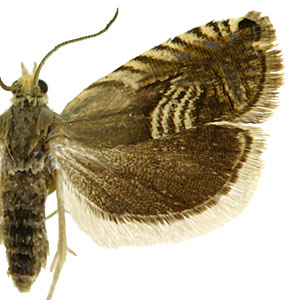Overview

The worldwide genus Grapholita contains approximately 125 described species. Its members are divided into two subgenera, Grapholita and Aspila, and are defined by a pair of coremata and short lateral projections on the eighth sternite in the male. Adults are small (FWL 3.5-8.0 mm) and brown, usually with white markings and a well-defined ocellus. Many species have bright white costal strigulae and one or more pairs of dorsal strigulae. Male genitalia are characterized by the absence of an uncus and socii, and a well-defined, densely setose cucullus. Female genitalia are characterized by a short ductus bursae and two thornlike signa in the corpus bursae in many species.
This genus contains many well known tortricid pests, such as the oriental fruit moth (G. molesta), cherry fruit worm (G. packardi), lesser apple worm (G. prunivora), and plum fruit moth (G. funebrana). Larvae are internal feeders in fruit and can cause significant economic damage to stone-fruits (almonds, apricots, cherries, nectarines, peaches, pears, plums, etc.). The white to reddish larvae resemble those of other internal-feeding olethreutines, such as Cydia, but larvae of the two genera can usually be separated by the anal fork, which is present in many Grapholita and absent in most Cydia. For more information on Grapholita larvae, please consult the fact sheet and keys on LepIntercept - An identification resource for intercepted Lepidoptera larvae.
With the exception of G. funebrana, all of the species treated here are present in the U.S. and are listed as non-targets. For photos of additional non-targets not covered here, visit the Moth Photographers Group link below.
Grapholita funebrana is one of the most important lepidopteran pests of stone-fruit in Europe and its exclusion from North America is a top priority. Grapholita larvae are commonly intercepted at U.S. ports of entry on a variety of products originating from Europe, Central America, and South America.
Target species
Grapholita funebrana
Non-target species
Grapholita delineana
Grapholita interstinctana
Grapholita molesta
Grapholita packardi
Grapholita prunivora
Links

The following external links require an internet connection. The authors, CSU, CDFA, and USDA/APHIS/PPQ/CPHST are not responsible for the availability or content of these external sites:
Moth Photographers Group - Grapholitini
References

Chen, M. H. and S. Dorn. 2009. Reliable and efficient discrimination of four internal fruit-feeding Cydia and Grapholita species (Lepidoptera: Tortricidae) by polymerase chain reaction-restriction fragment length polymorphism. Journal of Economic Entomology. 102: 2209-2216.
Gilligan, T. M., D. J. Wright and L. D. Gibson. 2008. Olethreutine moths of the midwestern United States, an identification guide. Ohio Biological Survey, Columbus, Ohio. 334 pp.
Komai, F. 1999. A taxonomic review of the genus Grapholita and allied genera (Lepidoptera: Tortricidae) in the Palaearctic region. Entomologica Scandinavica Supplement 55. 226 pp.
Razowski, J. 2003. Tortricidae of Europe, Vol. 2, Olethreutinae. Frantisek Slamka, Slovakia. 301 pp.
Rothschild, G. H. L. and R. A. Vickers. 1991. Biology, ecology and control of the oriental fruit moth, pp. 389-412. In: L. P. S. van der Geest, H. H. Evenhuis (eds.), Tortricid pests, their biology, natural enemies and control. Elsevier, Amsterdam, The Netherlands.
Weires, R. and H. Riedel. 1991. Other tortricids on pome and stone fruits, North American species, pp. 313-434. In: L. P. S. van der Geest, H. H. Evenhuis (eds.), Tortricid pests, their biology, natural enemies and control. Elsevier, Amsterdam, The Netherlands.

